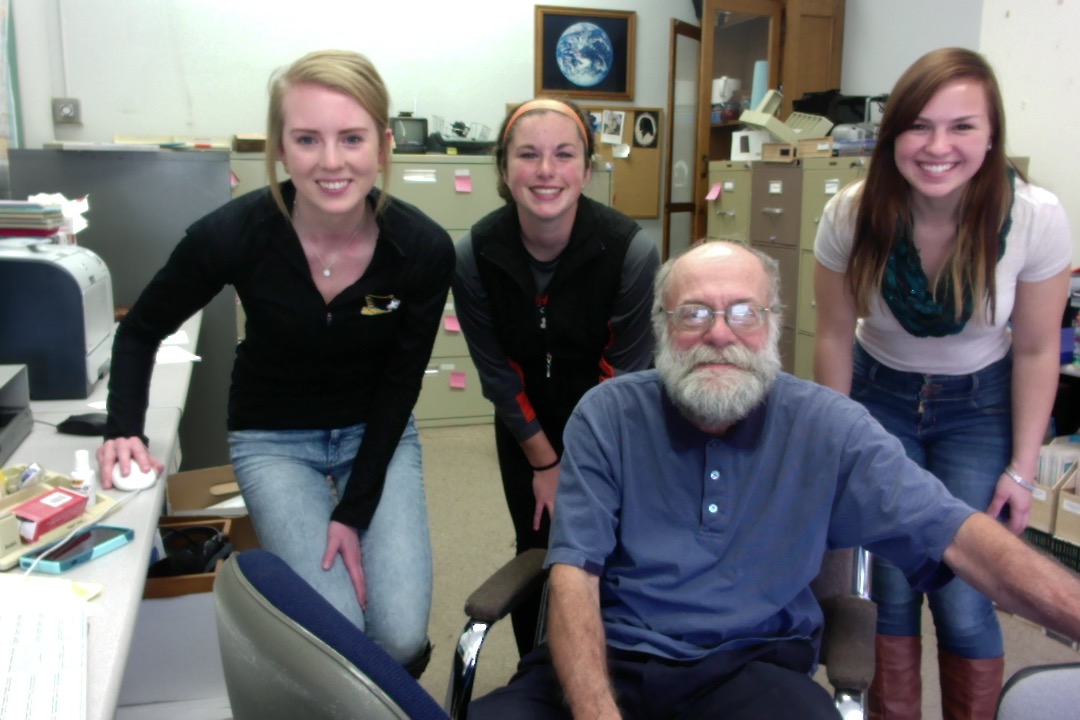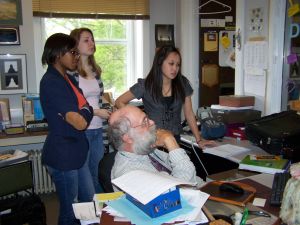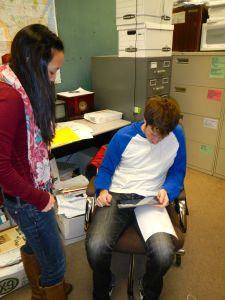
Dog tired as I try to bring the semester to a soft landing, I rely more and more on my student assistants to provide support in my research efforts.
I invited student research assistants Alison and Arianna to investigate the usefulness of Scoop.it.” as a teaching/learning tool. Here are their preliminary thoughts.
Scoop.it is a curating media web tool that allows individuals to find content for any topic imaginable. From these topics, it then creates an organized online magazine format. The components of Scoop.it are users, topics, and scoops. The potential users are anybody that has a Scoop.it account and can share articles about any topic. The topics can consist of anything, your favorite sport, a paper for school, current news events, and multiple endless possibilities. The scoops are the articles that are stored under the topic board/page for that specific topic. The free account for Scoop.it allows users to create two topic boards, connect two social media accounts, and scoop 10 articles a day.
To create a topic, one selects the “create a topic” button that is located on the user’s profile page. Once the button is selected, Scoop.it will then prompt you to fill out information about your topic. One inserts the name of the topic, selects the language, and then inserts a couple of key words about the topic. Inserting these key words allows Scoop.it to search for content that may be germane to your topic.
To find content yourself, a search bar in the top right corner allows one to type in keywords. The search will then produce three tabs related to the keywords; posts, topics, and users. The posts tab finds articles and content that is related to the keywords that were searched. Based on the keywords, topic boards that are created by other users will also be pulled up. If one wishes, one can follow a topic board which is then added automatically to one’s “follow” list. By following a topic board, one will be notified of the new content the user scoops into that topic board.
The topic board is a page that displays all of the curated content on the selected topic. In an organized fashion, the topic board arranges all the content you selected for that specific topic. By default, the content and articles are published in chronological order on the topic board.
When one finds an article that they want to scoop into their particular topic board, there is a scoop.it button on the article. This button allows one to select which curated topic board to add the scoop in, add additional text to the article, share this article with other social media sites, select a schedule of publication for the article, and add tags to the article.
Scoop.it allows individuals to share scoops with other social media sites without publishing the scoop under one of their topic boards. On the bottom right of a scoop is an arrow button that give you options of your other social media platforms to share the article with. Some versions of Scoop.it also provide the embedding code to include in a blog piece or to a website.
For convenience, Scoop.it has a web based platform and an app for mobile devices which syncs everything automatically across devices and platforms (e.g. desktop, iPad, iPhone, and Android).
There is an education version of Scoop.it that allows for 30 co-curators or groups to collaborate on a project. One is able to search for topics that may aid in papers, research projects, and class presentations. Teachers can create topic boards for a class and attach additional readings of articles that may enhance understanding of the material for the students. It can be used in conjunction with other learning tools such as SlideShare and PowerPoint.
We welcome any feedback or experience with Scoop.it.
Tag: blogging tools
Leveraging My Technology Learning Tools

I am sandwiching in (actually eating donuts!) some brief writing time between my two labs for Statistics and Experimental Design (PSY205). The students seem to have indeed come in prepared, having looked at the screen cast I had made using Screenflow for them about how to do a two-way, between subjects ANOVA with SPSS. One of my students offered to use Quizlet to make a review for their fellow students of the “language of statistics.”
Student research assistant Alison has been at work in my office since 8:00 updating our Macs with the new WordPress app. With no formal direction from me, she has reviewed our latest blogs, given thought as to how we can (and if we should) move up in the “elearning feeds ratings” and investigated how to use CreateSpace for the book we shall be writing together. I alert her to several more tools i want her and my other three student assistants to explore: Scoop.it, Paper.li, and either Feedly or Inoreader. She bounces the idea off me of my mentoring a Carroll Pioneer Scholar research program about technology learning tools.
I check my Twitter feed and discover Much Ado about Nothing brouhaha among Wikipedia editors. That might make my colleague and Shakespearean scholar (and Object Lesson author) John Garrison laugh. I share it with John. Time to head back to teaching my 2nd lab. Technology CAN be a tool as long as I don’t allow it to control me.
It's about Time: Carpe Diem
A canceled meeting! How best to make use of that unexpected 50 minutes—that gift of time. I know, let’s see whether this new faster, better, WordPress.com Mac app lives up to its promise.
How best to use this unexpected time? Catch up on the last 10 Profhacker blog pieces that sit on my RSS feed? Here are five of them:
- When technology changes on you? Seems germane.
- Slowing down and learning about “deep listening”? First I should close my door since too many of my colleagues lecture loudly with open doors. Second, I should also turn off my twitter feed that tempts me with messages from some of my favorite thought leaders. I am easily distracted yet try to avoid using technology to reduce distractions and undermine my self-control.
- Hints for teaching a large online course. Germane to a Task Force I am on exploring the viability of online courses—-perhaps at a graduate level— at my institution.
- Making a WordPress Site Multi-lingual: One of my goals for next semester is to engage in more global outreach.
- Exploring “gamification“: I’m still somewhat chary of moving in this direction
Finished reading last night David Mitchell’s erie, spell-binding, soul-sucking novel Slade House. Maybe those Atemporals caused the Carroll computer to crash just now necessitating my completing this blog on my cell phone!
Cascading Technology Learning Tools Into the Classroom: Student Authored Guides

Inspired by the release of Jane Hart’s latest 2015 Learning Tool Guidebook (well worth the purchase and careful reading), my students and I are in the process of writing Student Guides to the tools THEY find of most value at this point in their lives. Initially we’ll release them as blog posts. We welcome feedback. At the end of this semester we hope to bundle them together and post them as a Kindle-formatted e-book using a program like CreateSpace.
Augmenting My Teaching Capabilities: Top Technology Learning Tools Revisited

Caveat Lector: This blog piece is laden with hypertext links that lead you to additional thoughts I have about these learning tools!
With the deadline for responding to Jane Hart’s annual list of top learning tools imminent, here are my present thoughts on my top technology learning tools:
Reading: I need tools that increases the likelihood of my being able to stay abreast of current events and aware of current research findings that I then can incorporate into my classes in an ongoing basis. Driving to school today while listening to NPR I was alerted to some research dealing with “nudging” individuals to buy more healthy foods by partitioning grocery carts. When my commute was temporarily blocked by a Waukesha train, I took the time to dictate into my cell phone that I should incorporate “nudging research” into my experimental social psychology class. I later added that particular NPR stream to my RSS reader/aggregator. Though I have tried Feedly, I am presently using Inoreader.
I do a lot of online reading, (though I am convinced by Naomi Baron that the printed book has a bright future– Lego Ergo Sum) heeding and feeding my need to learn from Twitter (where I tend to follow a selective list of individuals who share or enlarge my interests), Facebook (where I maintain relationships with former students), and LinkedIn (which has some interesting capabilities for also keeping in touch with alumnae, Board of Trustees, and professional contacts).
Writing: I enjoy writing, and have investigated all of the writing tools on Jane’s list. I also have far-too-many writing (and other) apps on my far-too-many computers which I use across the day. My favorite journaling app of the moment is Day One. Its simplicity (and beauty) intrigues me and it motivates (nags) me to write. Of the six blogging pieces of software I have investigated I continue to use WordPress . It continues to teach me, and it gives me access to a number of individuals who write better than I. It is important to me that I learn from them. As I continue to try and reach out to non-English speaking audiences I am always looking for good language translation software that improves upon Google Translate.
Arithmetic: Among the courses I teach is “Statistics and Experimental Design.” I am also a partner of a consulting firm with Gregory K. Schneider and Jane Schneider. For data analysis purposes I use (and teach) SPSS, the Statistical Package for the Social Sciences though I follow very closely the possibility of switching to something (which is as all encompassing but more user-friendly and which is open source) such as JASP. For conducting surveys I teach and use SurveyMonkey.
Testing/ Quizzing: I continue to search for the ideal Testing/Quizzing tool. Though I have examined ProProfs Quizmaker and Quizlet, I still find of most value a much outdated but still reliably serving my needs software StarQuiz.
Screen Casting: Of the many screen casting tools I have explored, I keep coming back to using Screenflow though I am determined to give Camtasia (both Mac and PC versions) a thorough examination this academic year. I’ve been able to use such software to incorporate into my Statistics classes supplemental tutorials on the use of SPSS. I prefer using Vimeo to YouTube as an outlet for my video productions.
Other Tools on my shortlist for mastering this academic year are Evernote, Imovie, and either Scoopit or Paperli.
What tools do you use to augment your teaching capabilities? What evidence do you have of their success—-or failure?
I welcome your thoughts.
Movenote Revisited
Across my 35 years of teaching at Carroll I have been blessed to have highly skilled, patient, playful student research assistants who cheerfully and ably respond to my hurried, fly-by” task assignments such as “learn how to use Movenote and report back to me its potential value”. Thank you, student friends, for your support and for your being part of Dr. Simpson’s Neighborhood. Here is a result from our early explorations this year of the capabilities of Movenote – Click on the link: Angela and Amy Tutorial on Movenote.
Here is an example of what Angela learned THIS SEMESTER about how Movenote has evolved—Click on this link: Much has improved!
I have much for which to be thankful as a professor. Especially I am thankful for the delightful opportunities to learn along with students such as these!
Why Blog (Redux)?
I initially made a number of many half-hearted attempts at blogging about seven years ago but didn’t seriously start using blogging tools until I was awarded an opportunity to become an online “community blogger” as “Curious David” for the Milwaukee Journal Sentinel. It was during that year that I discovered the seminal technology tool dissemination work of my “virtual” mentor the indefatigable, never seems to sleep Jane Hart. Thank you, Jane, for your idealism, generosity, and persistence. I value your collegiality.
I was also blessed to have a supportive editor who gave me free license to explore Web tools and to write about whatever I cared to. Given freedom to explore I rediscovered the joys and challenges of writing. The following year I was given the opportunity to teach a semester-long course on Web learning tools to 25 Carroll (then) College freshmen. Blogging was one tool I introduced to them.
One of the best books about the history of blogging I have read is Suzanne Stefanac’s dispatches from blogistan.: a travel guide for the modern blogger. Thoughtful,witty, pithy, practical,thought-provoking—it opened my mind to the value of blogging tools.
I have investigated the relative strengths and weaknesses of WordPress, TypePad, Edublogs, Blogger, and Tumblr. In part because of the beautiful and lucid book Teach Yourself Visually WordPress by Janet Majure —I find I prefer the printed copy to the Kindle version— I have decided to invest a good deal of time exploring what WordPress blogging tools allow me to do. WordPress.com itself provides so many rich learning resources.
As Suzanne Stefanac points out, some blogs are linkfests, others diaries, some serve as club houses, others as news rooms, still others as soapboxes. I blog when I feel I have something to say that might be of interest to others. I have an enduring interest in life-long learning and enjoy sharing what I learn. I have no particular interest in having a large number of followers, but do I cross-post to Linked-in, Twitter, and Facebook because those are venues that allow me to stay in touch with friends, former students, and people I learn so much from. I welcome comments and feedback. In the past few years I’ve corresponded with a large number of interesting individuals from acoss the world who have enriched my life and informed my teaching and learning.
Here are some topics I am thinking of exploring in the new future:
- Time
- Popularizing (psychological) science with integrity
- Favorite Books–or bookmarks!
- On the strangulating limits of (over) efficiency
- Ten psychological findings that have impacted my life
- On replication
- Fraud in Psychology
- Best Courses
- Canine Companions
- Creativity
- Current topics in psychology





